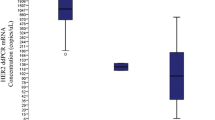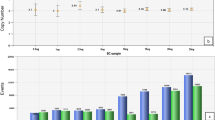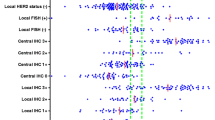Abstract
HER2 plays an important role in breast cancer progression and provides predictive and prognostic information. HER2 receptor family members function through dimerisation, which can lead to impact on cell function, growth and differentiation; however, their value in breast cancer development remains to be defined. This study aims to examine the relationships of HER2 heterodimers to breast cancer characteristics in trastuzumab naïve and treated cases. HER2 protein (IHC), HER2 gene (chromogenic ISH) and HER2 heterodimerisation status [chromogenic in situ proximity ligation assay (PLA)] were assessed in two breast cancer series prepared in tissue microarray (TMA) format. A range of signals/cell for each HER2 heterodimer was detected (0–34.6 signals/cell). The vast majority of cases with HER2 heterodimers showed HER2 gene amplification and/or protein expression. There was an association between HER2 dimerisation with HER3 and HER4 and their protein expression level but no such association was found in with HER1 (EGFR). Of the HER2+ cases, 74, 66, and 58 % showed heterodimers with EGFR, HER3 and HER4, respectively. 51 % of HER2+ tumours expressed all three heterodimers whereas 23 % of the cases did not show expression of any of the three heterodimers. There was an inverse association between the presence and levels of HER2 heterodimers and hormone receptor expression in HER2+ tumours. Tumours exhibiting high levels of HER2 heterodimers demonstrated aggressive clinicopathological features and poor outcome. In the HER2+ cases, dimerisation with EGFR and HER3 but not with HER4 showed an association with aggressive features. There was no association between HER2 heterodimers with patient breast cancer-specific survival or recurrence in HER2+ breast cancer in those patients receiving trastuzumab or not. Our results demonstrate that HER2 dimerisation is a complex process that may underlie the biological heterogeneity of HER2 positive tumours and may identify patients suitable for a specific targeted therapy but does not predict patient outcome for those receiving trastuzumab. PLA proved to be a useful tool for detecting, visualising and quantifying the frequency of protein–protein interactions in archival formalin-fixed paraffin-embedded tissue samples.



Similar content being viewed by others
Abbreviations
- HER:
-
Human epidermal growth factor receptor
- RTKs:
-
Receptor tyrosine kinases
- EGF:
-
Epidermal growth factor
- STATs:
-
Signal transducer and activation of transcription
- PI3K:
-
Phosphatidylinositol (PtdIns) 3-kinase
- IHC:
-
Immunohistochemistry
- ER:
-
Oestrogen receptor
- NPI:
-
Nottingham Prognostic Index
- PgR:
-
Progesterone receptor
- TN:
-
Triple negative phenotype
- ASCO:
-
American Society of Clinical Oncology
- CISH:
-
Chromogenic in situ hybridisation
- TMA:
-
Tissue microarray
- PLA:
-
In situ proximity ligation assay
- HRP:
-
Horse radish peroxidase
References
Curtis C, Shah SP, Chin SF, Turashvili G, Rueda OM, Dunning MJ, Speed D, Lynch AG, Samarajiwa S, Yuan Y, Gräf S, Ha G, Haffari G, Bashashati A, Russell R, McKinney S; METABRIC Group, Langerød A, Green A, Provenzano E, Wishart G , Pinder S, Watson P, Markowetz F, Murphy L, Ellis I, Purushotham A, Børresen-Dale AL, Brenton JD, Tavare S, Caldas C, Aparicio S (2012) The genomic and transcriptomic architecture of 2,000 breast tumours reveals novel subgroups. Nature 486:346–352
Tsuda H (2008) Individualization of breast cancer based on histopathological features and molecular alterations. Breast Cancer 15(2):121–132
Yu DH, Hung MC (2000) Overexpression of ErbB2 in cancer and ErbB2-targeting strategies. Oncogene 19(53):6115–6121
Slamon DJ, Clark GM, Wong SG, Levin WJ, Ullrich A, Mcguire WL (1987) Human breast cancer: correlation of relapse and survival with amplification of the HER-2lneu oncogene. Science 235:177–183
Witton CJ, Reeves JR, Going JJ, Cooke TG, Bartlett JM (2003) Expression of the HER1–4 family of receptor tyrosine kinases in breast cancer. J Pathol 200:290–297
Koninki K, Tanner M, Auvinen A, Isola J (2009) HER-2 positive breast cancer: decreasing proportion but stable incidence in Finnish population from 1982 to 2005. Breast Cancer Res 11(3):R37
Gschwind A, Fischer OM, Ullrich A (2004) The discovery of receptor tyrosine kinases: targets for cancer therapy. Nat Rev Cancer 4(5):361–370
Vandergeer P, Hunter T, Lindberg RA (1994) Receptor protein-tyrosine kinases and their signal-transduction pathways. Annu Rev Cell Biol 10:251–337
Zwick E, Bange J, Ullrich A (2001) Receptor tyrosine kinase signalling as a target for cancer intervention strategies. Endocr Relat Cancer 8(3):161–173
Heldin CH (1996) Protein tyrosine kinase receptors. Cancer Surv 27:7–24
Hudis CA (2007) Drug therapy: trastuzumab mechanism of action and use in clinical practice. N Engl J Med 357(1):39–51
Burgess AW, Cho HS, Eigenbrot C, Ferguson KM, Garrett TPJ, Leahy DJ, Lemmon MA, Sliwkowski MX, Ward CW, Yokoyama S (2003) An open-and-shut case? Recent insights into the activation of EGF/ErbB receptors. Mol Cell 12(3):541–552
Tzahar E, Waterman H, Chen XM, Levkowitz G, Karunagaran D, Lavi S, Ratzkin BJ, Yarden Y (1996) A hierarchical network of interreceptor interactions determines signal transduction by neu differentiation factor/neuregulin and epidermal growth factor. Mol Cell Biol 16(10):5276–5287
Bartlett JMS, Ibrahim M, Jasani B, Morgan JM, Ellis I, Kay E, Connolly Y, Campbell F, O’Grady A, Barnett S, Miller K (2009) External quality assurance of HER2 FISH and ISH testing 3 years of the UK National External Quality Assurance Scheme. Am J Clin Pathol 131(1):106–111
Vogel CL, Cobleigh MA, Tripathy D, Gutheil JC, Harris LN, Fehrenbacher L, Slamon DJ, Murphy M, Novotny WF, Burchmore M, Shak S, Stewart SJ, Press M (2002) Efficacy and safety of trastuzumab as a single agent in first-line treatment of HER2-overexpressing metastatic breast cancer. J Clin Oncol 20:719–726
Burris H, Yardley D, Jones S, Houston G, Broome C, Thompson D, Greco FA, White M, Hainsworth J (2004) Phase II trial of trastuzumab followed by weekly paclitaxel/carboplatin as first-line treatment for patients with metastatic breast cancer. J Clin Oncol 22(9):1621–1629
Slamon DJ, Jones BL, Shak S, Fuchs H, Paton V, Bajamonde A, Fleming TEW, Wolter J, Pegram M, Baselga J, Norton L (2001) Use of chemotherapy plus a monoclonal antibody against Her2 for metastatic breast cancer that overexpresses Her2. N Engl J Med 344(11):783–792
Baselga J, Rischin D, Ranson M, Calvert H, Raymond E, Kieback DG, Kaye SB, Gianni L, Harris A, Bjork T, Averbuch SD, Feyereislova A, Swaisland H, Rojo F, Albanell J (2002) Phase I safety, pharmacokinetic, and pharmacodynamic trial of ZD1839, a selective oral epidermal growth factor receptor tyrosine kinase inhibitor, in patients with five selected solid tumor types. J Clin Oncol 20(21):4292–4302
Barros FF, Powe DG, Ellis IO, Green AR (2010) Understanding the HER family in breast cancer: interaction with ligands, dimerization and treatments. Histopathology 56:560–572
Spears M, Taylor KJ, Munro AF, Cunningham CA, Mallon EA, Twelves CJ, Cameron DA, Thomas J, Bartlett JM (2011) In situ detection of HER2:HER2 and HER2:HER3 protein–protein interactions demonstrates prognostic significance in early breast cancer. Breast Cancer Res Treat 132(2):463–470
Shinichi Tsutsui AK, Ohno Shinji, Murakami Shigeru, Kinoshita Junko, Hachitanda Yoichi (2002) Prognostic and predictive value of epidermal growth factor receptor in recurrent breast cancer. Clin Cancer Res 8:3454–3460
Sainsbury JRC, Malcolm AJ, Appleton DR, Farndon JR, Harris AL (1985) Presence of epidermal growth-factor receptor as an indicator of poor prognosis in patients with breast-cancer. J Clin Pathol 38(11):1225–1228
Toi M, Tominaga T, Osaki A, Toge T (1994) Role of epidermal growth-factor receptor expression in primary breast-cancer: results of a biochemical-study and an immunocytochemical study. Breast Cancer Res Treat 29(1):51–58
Suo Z, Risberg B, Klasson MG, Willman K, Tierens A, Skovlund E, Nesland JM (2002) EGFR family expression in breast carcinomas. c-erbB-2 and c-erbB-4 receptors have different effects on survival. J Pathol 196:17–25
Abd El-Rehim DM, Ball G, Pinder SE, Rakha E, Paish C, Robertson JF, Macmillan D, Blamey RW, Ellis IO (2005) High-throughput protein expression analysis using tissue microarray technology of a large well-characterised series identifies biologically distinct classes of breast cancer confirming recent cDNA expression analyses. Int J Cancer 11:340–350
Abd El-Rehim DM, Pinder SE, Paish CE, Bell JA, Rampaul RS, Rwblamey J, Robertson FR, Nicholson R, Ellis I (2004) Expression and co-expression of the members of the epidermal growth factor receptor (EGFR) family in invasive breast carcinoma. Br J Cancer 91:1532–1542
Margolis BL, Lax I, Kris R, Dombalagian M, Honegger AM, Howk R, Givol D, Ullrich A, Schlessinger J (1989) All autophosphorylation sites of epidermal growth factor (EGF) receptor and HER2/neu are located in their carboxyl-terminal tails. Identification of a novel site in EGF receptor. J Biol Chem 264(18):10667–10671
Zhang XW, Gureasko J, Shen K, Cole PA, Kuriyan J (2006) An allosteric mechanism for activation of the kinase domain of epidermal growth factor receptor. Cell 125:1137–1149
Ellis IO, Galea M, Broughton N, Locker A, Blamey RW, Elston CW (1992) Pathological prognostic factors in breast-cancer. II. Histological type. Relationship with survival in a large study with long-term follow-up. Histopathology 20(6):479–489
Elston CW, Ellis IO (1991) Pathological prognostic factors in breast cancer. I. The value of histological grade in breast cancer: experience from a large study with long-term follow-up. Histopathology 19(5):403–410
Galea MH, Blamey RW, Elston CE, Ellis IO (1992) The Nottingham Prognostic Index in primary breast cancer. Breast Cancer Res Treat 22(3):207–219
Rakha EA, El-Rehim DA, Paish C, Green AR, Lee AHS, Robertson JF, Blamey RW, Macmillan D, Ellis IO (2006) Basal phenotype identifies a poor prognostic subgroup of breast cancer of clinical importance. Eur J Cancer 42(18):3149–3156
Rakha EA, El-Sayed ME, Green AR, Lee AHS, Robertson JF, Ellis IO (2007) Prognostic markers in triple-negative breast cancer. Cancer 109(1):25–32
Rakha EA, Elsheikh SE, Aleskandarany MA, Habashi HO, Green AR, Powe DG, El-Sayed ME, Benhasouna A, Brunet J-S, Akslen LA, Evans AJ, Blamey R, Reis-Filho JS, Foulkes WD, Ellis IO (2009) Triple-negative breast cancer: distinguishing between basal and nonbasal subtypes. Clin Cancer Res 15(7):2302–2310
Camp RL, Dolled-Filhart M, Rimm DL (2004) X-tile: a new bio-informatics tool for biomarker assessment and outcome-based cut-point optimization. Clin Cancer Res 10(21):7252–7259
de Azambuja E, Cardoso F, de Castro G, Colozza M, Mano MS, Durbecq V, Sotiriou C, Larsimont D, Piccart-Gebhart MJ, Paesmans M (2007) Ki-67 as prognostic marker in early breast cancer: a meta-analysis of published studies involving 12,155 patients. Br J Cancer 96(10):1504–1513
Gerdes J, Schwab U, Lemke H, Stein H (1983) Production of a mouse monoclonal-antibody reactive with a human nuclear antigen associated with cell-proliferation. Int J Cancer 31(1):13–20
Graus-Porta D, Beerli RR, Daly JM, Hynes NE (1997) ErbB-2, the preferred heterodimerization partner of all ErbB receptors, is a mediator of lateral signaling. EMBO J 16(7):1647–1655
Prenzel N, Fischer OM, Streit S, Hart S, Ullrich A (2001) The epidermal growth factor receptor family as a central element for cellular signal transduction and diversification. Endocr Relat Cancer 8(1):11–31
Zieba A, Wahlby C, Hjelm F, Jordan L, Berg J, Landegren U, Pardali K (2010) Bright-field microscopy visualization of proteins and protein complexes by in situ proximity ligation with peroxidase detection. Clin Chem 56(1):99–110
Soderberg O, Leuchowius K-J, Kamali-Moghaddam M, Jarvius M, Gustafsdottir S, Schallmeiner E, Gullberg M, Jarvius J, Landegren U (2007) Proximity ligation: a specific and versatile tool for the proteomic era. Genet Eng 28:85–93
Smirnova T, Zhou ZN, Flinn RJ, Wyckoff J, Boimel PJ, Pozzuto M, Coniglio SJ, Backer JM, Bresnick AR, Condeelis JS, Hynes NE, Segall JE (2012) Phosphoinositide 3-kinase signaling is critical for ErbB3-driven breast cancer cell motility and metastasis. Oncogene 31(6):706–715
Brennan PJ, Kumogai T, Berezov A, Murali R, Greene MI (2000) HER2/Neu: mechanisms of dimerization/oligomerization. Oncogene 19(53):6093–6101
Verbeek BS, Adriaansen-Slot SS, Vroom TM, Beckers T, Rijksen G (1998) Overexpression of EGFR and c-erbB2 causes enhanced cell migration in human breast cancer cells and NIH3T3 fibroblasts. FEBS Lett 425(1):145–150
Acknowledgments
We would like to thank the University of Nottingham for funding the Studentship.
Conflict of interest
The authors declare that they have no competing interests.
Author information
Authors and Affiliations
Corresponding author
Electronic supplementary material
Below is the link to the electronic supplementary material.
Rights and permissions
About this article
Cite this article
Barros, F.F.T., Abdel-Fatah, T.M.A., Moseley, P. et al. Characterisation of HER heterodimers in breast cancer using in situ proximity ligation assay. Breast Cancer Res Treat 144, 273–285 (2014). https://doi.org/10.1007/s10549-014-2871-4
Received:
Accepted:
Published:
Issue Date:
DOI: https://doi.org/10.1007/s10549-014-2871-4




